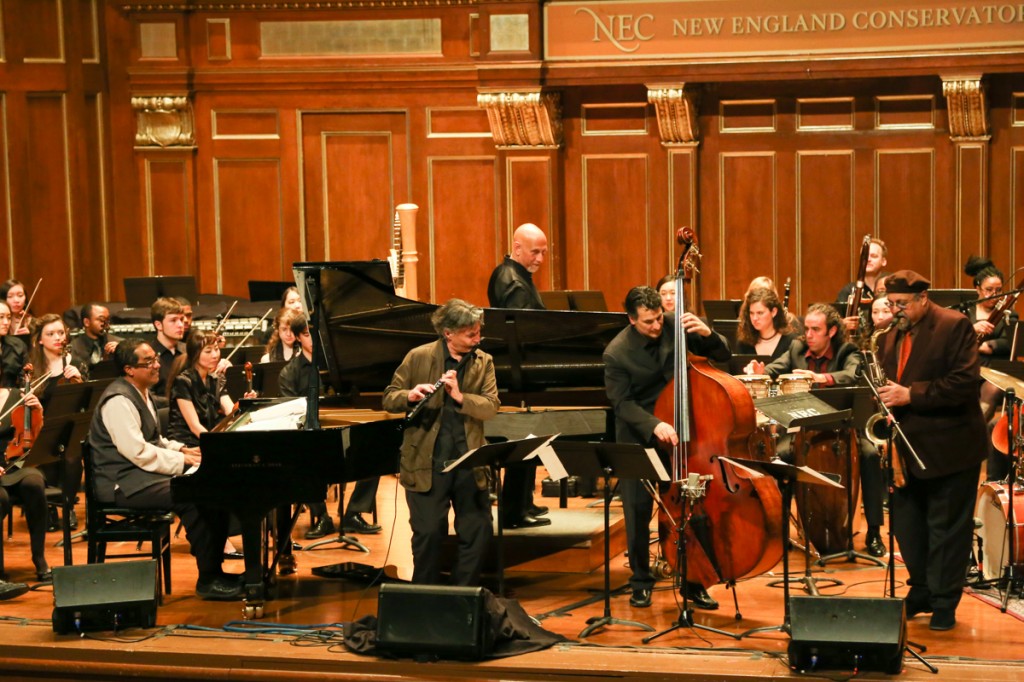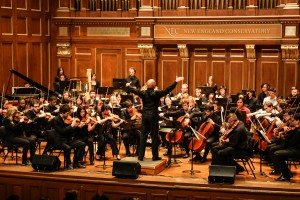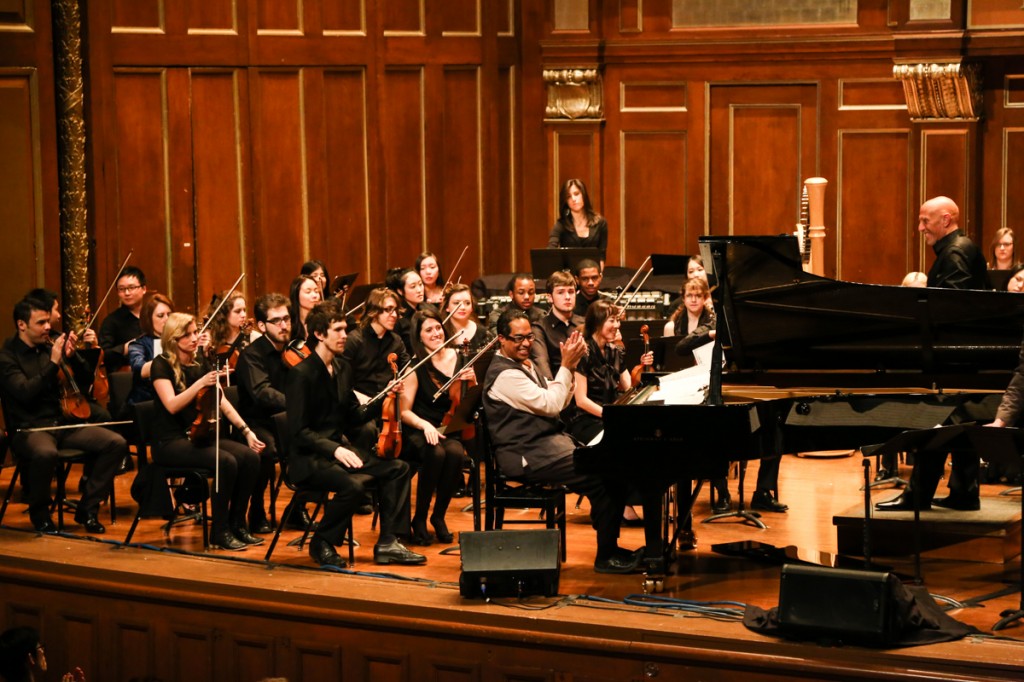Jazz Review: Berklee Contemporary Symphony Orchestra at Jordan Hall
The Berklee Contemporary Symphony Orchestra sought bravely to straddle the jazz and classical worlds with a little help from some star soloists.
By Steve Mossberg
“Contemporary” is a subjective term that gets thrown around a lot in both the jazz and classical worlds. The Berklee Contemporary Symphony Orchestra (BCSO) attempts, bravely, to effectively straddle the two. Under the baton of the undeniably hip conductor Francisco Noya, the BCSO presented some new-fangled classical and jazz in its Wednesday night program at Jordan Hall. The group had mixed success, fumbling a bit on one of the classics but soaring on a jazz set with accomplished guest soloists, including Danilo Perez, John Patitucci, Joe Lovano, and Adam Cruz.
On the all-classical first half of the program, it was pretty evident that the BCSO wasn’t playing concert music up to the level of student orchestras from NEC or Boston Conservatory. The group began with a well-conceived symphonic poem by young Berklee composer Aaron Gage. The students played the brief work, which is a metamorphosis of a Stravinsky-like theme, with energy and provided some very fine chorale work in the woodwind section, but they struggled occasionally with some of the odd-timed passages.
A suite from Prokofiev’s Romeo and Juliet was a wise pairing choice on Noya’s part—the pieces were united in terms of their Russian feeling and orchestral timbre. Unfortunately, things started going south in the first 10 measures or so, when the percussion section went out of balance at the first forte marking. This, along with some shaky brass work, resulted in a narrowing of the ensemble’s dynamic range that hampered it for the rest of the piece. However, in the third movement, “Masks,” something strange began to creep into the music—a sense of subtle swing. It’s definitely not supposed to be there, and may have been completely unintentional, but the orchestra became a bit funky nonetheless, and the sagging performance started to buck up—a hint that the ensemble had some real strengths yet to show.
Noya chose to close the first half with Mexican composer Arturo Márquez’s “Danzon #2,” the catchy piece that conductor Gustavo Dudamel has made famous in recent years with the Simon Bolivar Youth Orchestra. Before the BCSO began, Noya announced that “since this is Berklee, and we can’t leave anything alone” that they intended to “mess around with it.” All of a sudden, the orchestra came alive.

The Berklee Contemporary Symphony Orchestra brought out the big stars in the second half. Photo: Kristophe Diaz
Generally speaking, even when top-shelf bands like the BSO or New York Philharmonic play music with strong grooves, they come off as either hopelessly stiff or lose the score’s pulse in a sea of romantic rubato. In welcome contrast, the BCSO was tremendously soulful and in the pocket. They came off like real pros and, as promised, messed around with the piece—in the best possible way. There was an unannounced violin solo and a full-on salsa percussion breakdown, in which Noya directed the rest of the orchestra to clap claves on their hands. The audience joined in, resulting in a kind, happy, popular chemistry that is all too rare at classical performances.
In the second half of the program, Berklee brought out the big stars, and the orchestra rose to the occasion, coming off as a completely different band than in the first half. The chairs were pushed back into a crescent shape, and the front of the stage became a jazz club, with Adam Cruz sitting tall behind a drum kit and John Patitucci taking center stage on the double bass. After an elegiac bowed intro, the orchestra commenced his heartbreakingly beautiful “Communion,” with faculty soprano player Marco Pignataro taking honors on the melody and providing a remarkably restrained and classy solo.
Somewhat incongruously, the program continued with two cerebral arrangements of Frank Sinatra songs by the great Manny Albam. Heading the group for the ballads were the married couple of Joe Lovano on tenor sax and Judi Silvano on vocals. Silvano’s voice was crystal clear and muscular at the same time, blending beautifully with the string section. As she sang fragments of the original lyrics to “I’ll Never Smile Again” and “All the Way,” Lovano and flutist Matt Marvuglio were nimble contrapuntal soloists, weaving effortlessly in and out of the jagged orchestral lines.
Pianist Danilo Perez, no stranger to the classical world, was the featured artist on two selections from his orchestral CD Across the Crystal Sea. Both songs were simmering with quiet intensity, something that Adam Cruz does extremely well, and he propelled the large ensemble with highly inventive and dynamic brush playing. The conga player was a fantastic accompanist, shading the kit player’s rhythmic parts with great sensitivity. Perez was very sensitive to the nuances of Jordan Hall’s grand piano, and he played it like a gentlemen, improvising in a refined manner that played up his melodic development while simultaneously enhancing the sound of the accompanying orchestra.
The night ended with Patitucci’s funky, up-tempo “Voyager,” a piece whose gnarly orchestral stabs show the distinctive touch of an excellent and underrated composer. Patitucci’s bass playing, for which he’s much better known, did not disappoint either. It was clear that students were enjoying themselves as he and his band mates dug in deep on the solo sections. Lovano and Marvuglio returned to the stage for some incendiary improvisations as well, and Perez’s fast keyboard work was so dazzling that some of the orchestra members craned their necks or got out of their seats in order to see what his furious hands looked like in action.
The feeling at Jordan Hall was a warm one, and even during the weakest moments of the night, the BCSO was obviously getting a kick out of stepping over the borders it had set out to cross. Whether excelling on a Manny Albam chart, remixing Márquez’s oft-played showpiece, or struggling to stay on top of Prokofiev, the young ensemble’s merit was clear: an enthusiastic embrace of the connections made in the disparate music it performed.


